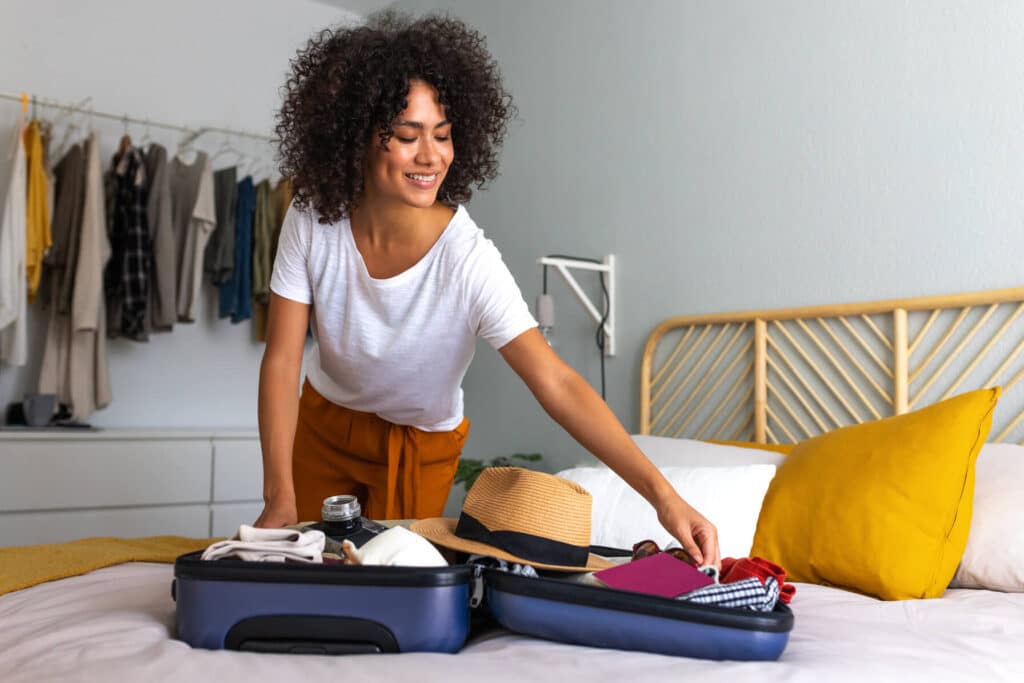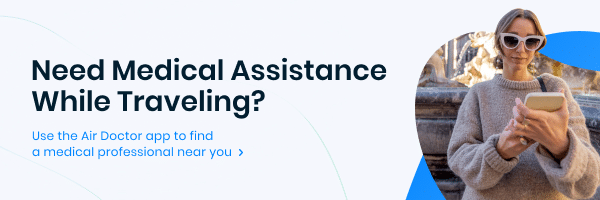Traveling with food allergies internationally can present unique challenges. But with careful planning and preparation, you can enjoy your time abroad while taking care of your health.
This guide is designed to equip you with essential steps and tips for navigating food allergies while traveling – from pre-trip preparations to dining out and emergency readiness. Whether you’re exploring exotic cuisines or seeking familiar comforts, your safety and enjoyment will be the ultimate factor in ensuring that your exploration of the world is a fulfilling and worry-free adventure.

Pre-Trip Preparation
If you’re looking to travel with food allergies, it’s important to make sure you’ve done some pre-trip prep.
Consult an Allergist
Before you travel, consult with an allergist to discuss your travel plans and get advice on managing your food allergies during the trip.
Ensure you have up-to-date prescriptions for an epinephrine auto-injector and any necessary medication.
Research Your Destination
Learn about the local cuisine, common allergens in the region, and any learn some local phrases to make sure you don’t accidentally eat something your body won’t agree with.
Medical Alert Bracelet
Consider wearing a medical alert bracelet that clearly states your food allergies, even in the local language.
Food Allergy Card
You should also consider getting food allergy cards for travel.
These cards, translated into the local language, clearly communicate your allergies and dietary restrictions to restaurant staff and chefs.
Insurance
It’s a good idea to get travel insurance for food allergies and other medical emergencies.
Most travel insurance companies will include food allergies as a pre-existing condition, which means that it’ll almost definitely be covered.
Choose Allergy-Friendly Accommodations
When booking accommodations, consider staying in places with kitchen facilities, such as vacation rentals or extended-stay hotels, so you can prepare safe meals.
If you’re staying with a host, make sure they’re aware of your food allergies beforehand.

Packing
Now that you’ve done your pre-trip research, it’s time to take a look at what you’ll pack to take with you on the plane.
Safe Snacks
Pack some safe snacks that you can eat during travel, or in case safe food options are limited.
Medication
Pack all necessary medication, including epipens, antihistamines, and any prescribed medication you may have. (We’ve got a great guide on Traveling with Prescriptions as well).
Doctor’s Note
Carry a letter from your allergist detailing your allergies, the need for medications, and emergency instructions. This can be helpful during security checks and when receiving healthcare abroad.
Air Travel
Traveling with food allergies internationally means you’ll need to make sure your airline know about dietary restrictions.
Inform the Airline
When booking your flight, inform the airline about your allergies.
Some airlines can accommodate special meal requests to meet your dietary needs.
Packing Food
If you’re packing your own food for the flight, ensure it adheres to airline regulations and is labeled clearly with your name and allergy information.
During the Trip
You’ve made it to your location! Here are a few things you can keep in mind when you’re out and about.
Stay Vigilant
Traveling with food allergies means you’ll always need to read food labels, even if the packaging looks familiar. Keep in mind that ingredients can vary by region.
Stay Hydrated
Drinking plenty of water can help reduce the impact of allergen exposure.
Air Doctor
The Air Doctor app is always available if you want to schedule a doctor’s appointment in the country you’re visiting to find out about common allergens, and if you’re unsure about a reaction you might be having after eating something.

Dining Out
Traveling always means sampling some local flavours. Here’s what you need to be aware of if you’re traveling with food allergies.
Research Restaurants
Research allergen-friendly restaurants at your destination. Look for reviews or online platforms that provide allergy-specific information.
Language Assistance
Know how to ask about specific ingredients and inform restaurant staff about your dietary restrictions.
Communicate Clearly
When dining out, inform your server about your food allergies. Clearly explain the allergens you need to avoid and ask about cross-contamination practices.
Order Simple Dishes
If you’re unsure or worried, it’s best to order simple dishes with fewer ingredients to minimize the risk of allergen exposure.
Emergency Preparedness
Of course, there’s always a chance that something goes wrong. But don’t worry! Here’s what you can do in the event that you do eat something you’re allergice to.
Emergency Contacts
Save local emergency numbers, the nearest hospital, and your country’s embassy or consulate contact information. If you’ve got travel insurance, find out which hospitals and clinics you can visit where you’ll be covered.
Emergency Action Plan
Share your emergency action plan with your travel companions, so they know how to respond in case of an allergic reaction.
Know the Symptoms
Familiarize yourself with the symptoms of an allergic reaction and how to use your epinephrine pen.

Returning Home
The trip might be done, but there’s still a little bit left to do in order to make sure you’ve got some handy info for your next trip.
Reflect and Learn
After your trip, take some time to reflect on what went well and what could be improved for future travels.
Share Feedback
If you find allergy-friendly restaurants, leave reviews or share recommendations with to help others with similar needs find those locations. And make sure to keep them in mind if you go there again.
Most Common Allergens:
While food allergies vary from person to person, the most commonly accepted “Big Ten” consists of:
- Milk: Including cow’s, goat’s, and sheep’s milk and their derivatives (cheese, yogurt, butter).
- Eggs: From chicken, duck, and quail, often found in baked goods, sauces, and processed foods.
- Peanuts: Legumes that can trigger severe reactions even in tiny amounts.
- Tree Nuts: Including almonds, walnuts, cashews, pistachios, and Brazil nuts.
- Soy: Found in a wide range of processed foods and often used as a protein source.
- Wheat: Found in bread, pasta, cereals, and many processed foods.
- Fish: Including salmon, tuna, and cod.
- Shellfish: Including shrimp, crab, and lobster.
- Sesame: Seeds and sesame oil used in various cuisines and baked goods.
- Sulfites: Used as a preservative in wines, dried fruits, and other processed foods.
Here are some commonly searched for countries, and the allergens you should look out for.
Traveling to Europe With Food Allergies
Traveling to Europe isn’t a great idea if you have food allergies, as European cuisines often use a variety of these allergens, so it’s important to be cautious and inquire about ingredients.
Traveling to Greece with Food Allergies
Common allergens in Greece include:
- Eggs: Used in various dishes and desserts.
- Nuts: Commonly used in desserts like baklava.
- Soy: Less prevalent in traditional Greek cuisine.
- Wheat: Found in bread and pastries.
- Fish/Shellfish: Coastal regions feature seafood dishes.
- Sesame: Used in some bread and baked goods.
- Sulfites: Present in wines and processed foods.
Traveling to Italy with Food Allergies
Common allergens in Italy include:
- Milk: Used in cheeses like mozzarella and ricotta.
- Eggs: Used in pasta and baked goods.
- Peanuts/Tree Nuts: Nuts may be used in desserts and sauces.
- Soy: Less common in traditional Italian dishes.
- Wheat: Prevalent in pasta, bread, and pizza.
- Fish/Shellfish: Coastal areas offer seafood dishes.
- Sesame: Used in some bread and dishes.
- Sulfites: Present in wines and preserved foods.
Traveling to Japan with Food Allergies
Common allergens in Japan include:
- Milk: Dairy not as prevalent in traditional Japanese dishes.
- Eggs: Found in some sauces and dishes.
- Peanuts/Tree Nuts: Occasionally used in sauces and desserts.
- Soy: Ubiquitous in soy sauce and tofu.
- Wheat: Found in soy sauce and some noodles.
- Fish/Shellfish: Staple of Japanese cuisine, especially sushi.
- Sesame: Present in dishes and dressings.
- Sulfites: Present in some processed foods.
Traveling to Mexico with Food Allergies
Common allergens in Mexico include:
- Milk: Present in cheeses and creams.
- Eggs: Used in various dishes and desserts.
- Peanuts/Tree Nuts: Found in sauces and desserts.
- Soy: Used in some sauces and processed foods.
- Wheat: Common in flour tortillas and sauces.
- Fish/Shellfish: Coastal regions offer seafood dishes.
- Sesame: Found in sauces and toppings.
- Sulfites: Present in some preserved foods.
Traveling to Spain with Food Allergies
Common allergens in Spain include:
- Milk: Used in cheeses like manchego.
- Eggs: Used in dishes and desserts.
- Peanuts/Tree Nuts: Nuts can be present in desserts.
- Soy: Less common in traditional Spanish dishes.
- Wheat: Found in bread and some dishes.
- Fish/Shellfish: Coastal areas feature seafood, notably in paella.
- Sesame: Used in some bread and dishes.
- Sulfites: Present in wines and processed foods.
Traveling with food allergies doesn’t have to be a daunting task. With some preparation and awareness, you’ll be able to enjoy your time abroad while making sure you take care of your health.













